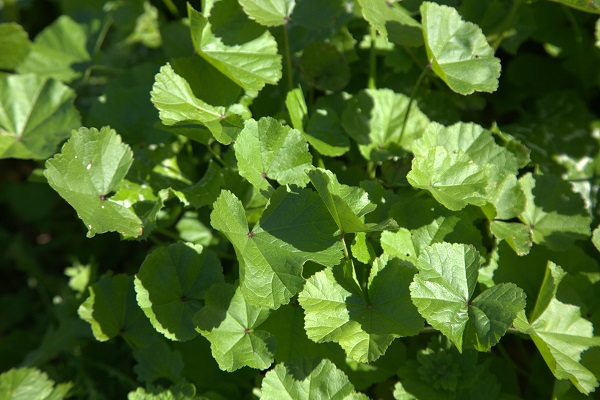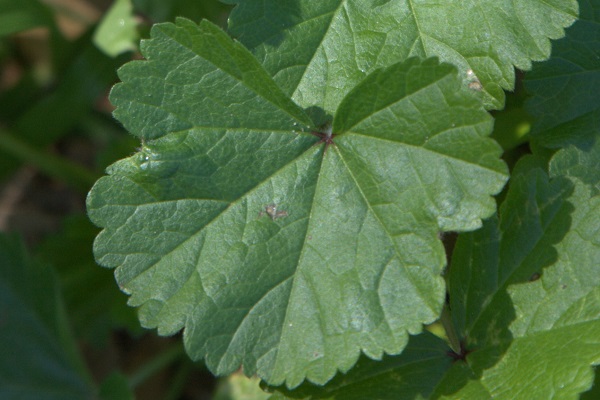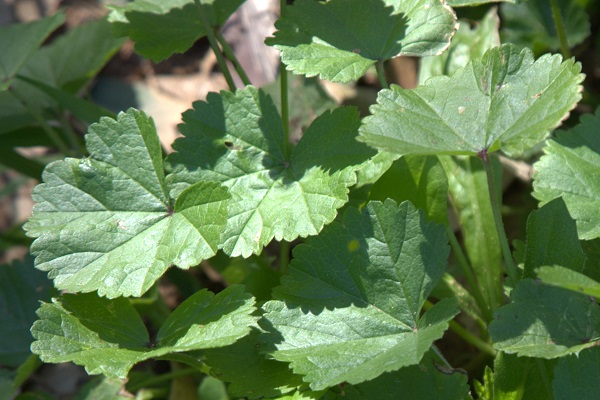Malva parviflora, Cheeseweed, Little Mallow,
Hebrew: חלמית קטנת-פרחים, Arabic: خبازة صغيرة الأزهار, Egypt: خبيزه "Khobbeiza"
|
|
| Scientific name: |
| Malva parviflora L. |
| Common name: |
| Cheeseweed, Little Mallow |
| Hebrew name: |
| חלמית קטנת-פרחים |
| Arabic name: |
| خبازة صغيرة الأزهار |
| Egypt: |
| خبيزه "Khobbeiza" |
| Family: |
| Malvaceae, Mallow Family, חלמיתיים |

|
|
|
| Life form: |
| Annual |
| Stems: |
| Up to 50cm high, erect, sprawling or decumbent herb; covered with stiff star-like (stellate) hairs |
| Leaves: |
| circular, 8-10cm in diameter; margins crenate, sparsely pubescent, palmately veined with 5-7 short trianguar lobes; petiole 1.5-12cm long and rarely 20cm. |
| Inflorescence: |
| Axillary, flowers solitary or in 2–4-flowered fascicles. |
| Flowers: |
| 5 White, pink petals about 4-6mm long; 8-12 carpels; 5 green orbicular(triangular) sepals; corolla is approximately as long as the calyx. |
| Fruits / pods: |
| Schizocarp, disc-shaped, 7-8mm in diameter and separates into 8-12, 1 seeded mericarps. |
| Flowering Period: |
| February, March, April, May |
| Habitat: |
| Nutrient-rich soils, ruderal |
| Distribution: |
| Mediterranean Woodlands and Shrublands, Semi-steppe shrublands, Shrub-steppes, Deserts |
| Chorotype: |
| Med - Irano-Turanian |
| Summer shedding: |
| Ephemeral |

Derivation of the botanical name:
Malva, from the Greek word "malache", meaning "mallow" and "malakos", "soft, gentle,", referring to the abundant mucilage in certain species, which softens the skin.
parviflora, parvus, small, little, insignificant; florus, floreo, to bloom, to flower; small flowered.
The Hebrew name: חלמית, halamit (Post Biblical Hebrew), Aramaic: חלמתא, halamta; Arabic: haluma.
- The standard author abbreviation L. is used to indicate Carl Linnaeus (1707 – 1778), a Swedish botanist, physician, and zoologist, the father of modern taxonomy.
Mallow known khubeizah, Arab Bread (the Arabic name khubeizah, hubeza, is from hubez, bread). The leaves of the mallow are edible only after they are cooked, which removes the slimy juice.
Malva became an important food source during the War of Independence. During the siege of Jerusalem, when convoys of food could not reach the city, Jerusalemites went out to the fields to pick the leaves and prepare from them a variety of dishes.
The leaves of Malva species are still used today in soups and salads.
Job characterizes "the juice of ḥallamut" ("mallow") as insipid, so that even in his distress "my soul refuses to touch them; they are as the sickness of my flesh" (Job 6:6).
Horace, Quintus Horatius Flaccus (65 BCE – 8 BCE), the Roman poet said his modest diet was made up mainly of olives, endives, and mallow, "Me pascunt olivae, me cichorea levesque malvae" Odes 1.31.15.
According to Marcus Gavius Apicius (a first century author of De Re Coquinaria (On Cookery), during the reign of Tiberius), the Romans boiled the leaves like spinach and served them as a vegetable.
Pliny (23 CE – 79 CE) mentions Malva in his book Natural History XX.222-227 : '... whoever swallows daily half a cyathus (cyathus= 45 ml) of the juice of any one of them will be immune to all diseases...The root of a single stem plant they stab around an aching tooth until the pain ceases... The root boiled in milk and taken as a broth it relieves a cough in five days'.
Rashi (Hebrew: רש"י, RAbbi SHlomo Itzhaki (Hebrew: רבי שלמה יצחקי; 1040 – 1105)), a medieval French rabbi, in his commentary on the vegetable adani (Shab. 35b) notes: "It is a vegetable called malva whose leaves turn to the sun. In the morning they incline eastward, at midday they are upright, and in the evening they incline westward."
Bible resources:
- Job 6:6-7
Is tasteless food eaten without salt, or is there flavor in the white of an egg?
I refuse to touch it; such food makes me ill.

|


